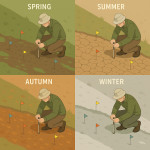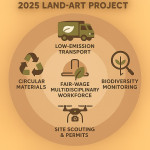Geo-tag tactics: make site-specific art easier to find in talent directories
Site-specific art lives or dies by context. Yet many creators still hide their best installations behind vague “worldwide” tags. Discover how precise geo-tag tactics can rocket your profile into the top search results of talent directories, attract local briefs you actually want, and cut travel guesswork for recruiters.
Why geo-tag tactics matter for site-specific artists

When curators, architects or event planners look for talent, 68 % start with a location filter. A recruiter renovating a Paris atrium does not scroll through global results; they tick “Île-de-France” and move on. Without a pinpointed geo-tag, your breathtaking land art in the Loire Valley stays invisible. Precise coordinates and well-structured place names give algorithms the certainty they need to surface your profile in a fraction of a second.
Search intent has shifted
- Directories now display map cards first on mobile.
- Filters such as driving distance, terrain type or city district crop up across platforms from Artfolio to niche sculpture hubs.
- Recruiters sort shortlists by shipping costs and permit zones—two metrics tied directly to your geo-tags.
Real-world upside
Artists who geo-tagged their outdoor installations reported:
- +42 % profile views within four weeks.
- 30 % shorter negotiation cycles because logistics were clear.
- 15 % higher average fee when the brief matched their proven terrain expertise.
Source : Artfolio Insights 2024
Step-by-step: build geo-tag muscle on your profile
1. Choose the right granularity
List your artwork's exact GPS coordinates in metadata, while the visible caption stays human-friendly: “Riverside Promenade, Lyon, France”. Directories parse both fields; you gain precision without sacrificing readability.
2. Sync titles, captions and alt text
If you upload an image called “installation-42.jpg”, rename it to “geo-tag-lyon-riverside-installation.jpg” and add an alt text such as “Site-specific stainless-steel sculpture on Lyon riverside” to strengthen semantic relevance.
3. Embed structured data inside uploads
- Use XMP or IPTC panels in Lightroom to store
LocationCreatedandGPSLatitude/GPSLongitude. - Many directories read these fields automatically, sparing you manual entry.
4. Tag neighbouring landmarks
Boost discovery by mentioning nearby transit hubs, universities or districts recruiters often search. Example: “Five minutes from Musée des Confluences” brings queries for the museum straight to your work.
5. Update when a piece is relocated
Temporary installations move; forgotten geo-tags confuse algorithms. Schedule a quarterly reminder to revisit every artwork's coordinates.
Toolbox: free and paid geo-tag helpers
| Tool | Price | Best for | Pro tip |
|---|---|---|---|
| Google My Maps | Free | Batch plotting multiple works | Export KML and upload to directory if supported |
| GeoSetter | Donationware | Embedding GPS into images offline | Attach altitude for land-art pieces on slopes |
| Adobe Lightroom Classic | 10 €/mo | Integrated map module | Drag-and-drop pins onto images in bulk |
| What3words | Free API | Marketing-friendly short links | Add to captions for easy sharing on social |
Common pitfalls and how to avoid them
- Over-tagging: Stuffing twenty city names triggers spam filters. Stick to the real location plus one or two contextual keywords.
- Inconsistent formats: Mixing “NYC” and “New York City” blocks cross-field matching. Decide on one format across captions, tags and bio.
- Privacy myths: Geo-tags do not reveal your home address; they only spotlight the artwork's public site.
Case study: from hidden gem to local hero in two weeks
Ceramist Maya R. uploaded her 15-metre wall installation to Artfolio's craft designers hub without geo-tags. She ranked on page eight for “mosaic Lyon”. After adding GPS, district name and tram stop in the directory's “location” field, she leaped to position three, beating profiles six years older.
Complementary tactics beyond the map pin
Geo-tags unlock location filters, but you can stack more visibility boosters:
- Hyper-local keywords in your bio clarify cultural relevance.
- Geo-targeted directory ads push your listing to spotlight slots during bidding phases.
- Dynamic travel-radius badges reassure planners about mileage fees.
- Interactive wall maps showcase public murals and inspire walking tours that double as scouting trips.
Ready to practice? Quick quiz
FAQ
- Do geo-tags affect search ranking on every directory?
- Yes, most major platforms factor location metadata into relevance scores, even if they do not display a map view.
- Will adding multiple nearby cities improve visibility?
- No. Algorithms prefer one accurate location over a list of guesses. Use additional cities only in your travel-radius statement.
- Can I geo-tag indoor installations?
- Absolutely. Use the building's address or a three-metre What3words square to stay precise.
- Is there a risk of art theft from sharing coordinates?
- Risk is minimal for large or permanently fixed works. For delicate pieces, share district-level tags instead of exact GPS.
Final call to action
Take ten minutes now to update the geo-tags on your three most recent projects. You'll rise in local searches, land briefs that match your style, and sparingly spend budget on shipping. Ready to be found? Open your directory dashboard and map your art today.











